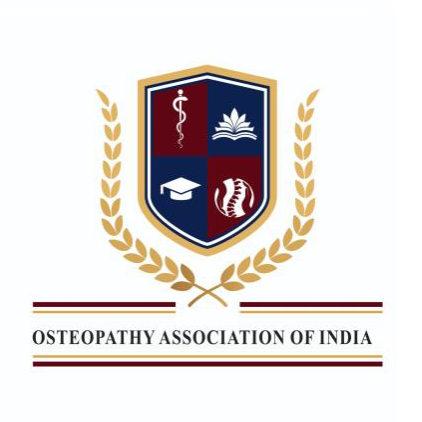About us

OSTEOPATHY
OSTEOPATHY PROFESSION
AFFILIATE ORGANIZATIONS
OAI EVENTS
Promoting the philosophy and practice of osteopathy in India
We represent more than 450 osteopaths and Osteopathy students across INDIA.
Osteopaths, believe that there’s more to good health than the absence of pain or disease. Their whole-person approach to medicine focuses on prevention, helping promote the body’s natural tendency toward health and self-healing.
Osteopathy is one of the fastest-growing health care professions in the country.
As a distinguished regulating body for Osteopaths and the accrediting agency for all osteopathic practices and courses in india, the OAI works to accentuate the distinctiveness of osteopathic principles and the diversity of the profession.
In addition to promoting public health and encouraging scientific research, the OAI advocates at the state and central levels on issues that affect Practicing osteopaths, osteopathic students and patients.
The OAI is committed to:
- Upgrading and adding value to OAI membership – Providing scientific resources, updating knowledge, adding high end technology, Business tools, healthcare soft wares, and support to advance your professional and personal goals.
- Protecting the rights of the Practicing Osteopaths – Advocating on your behalf to advance regulatory improvements, representing on your behalf to central and state governments and promote access to care.
- Promoteing the unique philosophy of Osteopathy and practice of osteopathy in India – Raising awareness of the unique treatment options available in Osteopathy to serve people each and every day.
- Supporting Osteopaths ability to give quality healthcare at affordable cost – Promoting health policy advancements that improve affordability and access.
- Collaborating with others to advance the practice of osteopathy in India – Working hand in hand with government authorities, lawmakers and the public to raise awareness.
The Objectives of OAI :
The objects for which the society is established are:
- To encourage and advance the study and practice of the Osteopathy in India. To promote and advance Osteopathic education and allied sciences in all their different branches and to promote the improvement of public health and medical education in India.
- To maintain the honour and dignity and to uphold the interest of the Osteopathy profession and to promote co-operation amongst the members thereof;
- Recognition of Osteopathy Profession in India.
- To promote social and academic interaction among the Osteopaths of India and Abroad.
- To encourage scientific research and experimental work in the field of Osteopathy.
- To organize scientific programmes such as Conferences, Workshops etc., to encourage their improvement of Osteopathic Practitioner.
- To provide for Continuing Medical Education (CME) programmes for postgraduate students and Health Professionals.
- To establish and maintain website, reference libraries of books, journals, Newsletters, audiovisual materials etc., relating to medical science with special attention to Osteopathy.
- To watch Government legislation affecting Osteopathy. To extend help to any deprived community, participate in prevention and treatment of health and medical conditions and other social welfare activities. To protect the interest of the members by helping them to deal with legal problems. Towards these legal, social, academic and financial goals to form a Federation of all osteopathic specialties.
- To submit representations on behalf of Osteopath Practitioners to the Government, to get Council and jobs in the Government Health Care sectors, etc.
- To publish books and journals devoted to Osteopathy and allied subjects.
- To arrange and conduct examinations including post graduate examinations and award certificates and prizes on subjects connected with Osteopathy.
- To establish and affiliate to autonomous medical Colleges / Institutes with attachments to various hospitals in India and abroad for education and training in Osteopathy and its various disciplines.
- To make rules, when deemed necessary, inter alia relating to discipline and professional conduct of Osteopathic Practitioners.
- To do all such other things as may be incidental to or conducive to the attainment of all or any of the above objects.
- To receive donations or other tangible help from the corporate as part of their CSR initiatives under Companies Act, 2013, or from other societies, public/charitable trusts, Government bodies.
- To purchase/acquire immovable property, including land and/or buildings in the name of the Society, for promoting “Equity and Excellence” with the right attitude and fulfilment of the aims and objectives of the Society.
- To perform all other acts that that may be necessary for the fulfilment of the aim and Objectives of the Society.
- To help, assist, contribute in cash or kind, to any association, institution or trust which has been approved under section 80G of the Income Tax Act, 1961, amended from time to time.
- To give legal assistance to practicing Osteopaths with Post Graduate Degree(as approved by OAI) in India.
- To file any legal suit against people who practice Osteopathy, without proper education from recognized institutions or Courses approved by OAI.
- Any Indian or foreign national, who wants to practice osteopathy in India has to be a registered member of OAI.
- Any Indian or foreign national, who wants to conduct any osteopathy courses in India has to get Prior Approval from OAI.
HISTORY OF OSTEOPATHY
The term ‘osteopathy’ was first used by Andrew Taylor Still in 1874. The origin of the word is from the Greek for bone (osteon) and suffering (pathos).
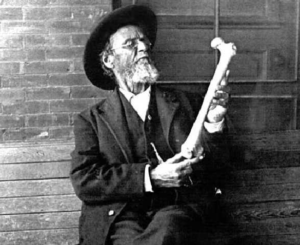

AT Still (1828-1917) was born in Virginia. He was the son of a physician and Methodist preacher, and elected to follow his father into medicine. After studying medicine and a working apprenticeship with his father, he entered the American Civil War (1861-65) as a hospital steward. However, his autobiography suggests that he was able to perform some surgery after showing a degree of medical knowledge and competence.
AT Still also mentions that in his early childhood, he was a persistent headache sufferer, and used to effect some relief by suspending a rope swing between 2 trees and resting his head and neck on it. One of the many experiences which were to be incorporated in the development of osteopathy.
The experiences of some of the basic and dangerous medical practices of the day and the loss of 3 of his children to spinal meningitis in 1864 led Still to the idea that current medicine was ineffective and there had to be another way. He devoted the next 30 years of this life to the development of what would become osteopathy.



After the civil war, Still became known as the ‘Lightning Bonesetter’ and his reputation for the ability to treat many conditions from dysentery to sciatica spread.
In 1892, Still took on the first wave of 22 osteopathic students at the American School of Osteopathy (now known as the Kirksville College of Osteopathic Medicine). The first class of both men and women (symbolic of Still’s strong sense of liberalism) were taught over a period of two years, and included in-depth education in physiology and anatomy. He drew in full practice rights for his students, and upon graduation, awarded them the title of D.O (Doctors of Osteopathy).

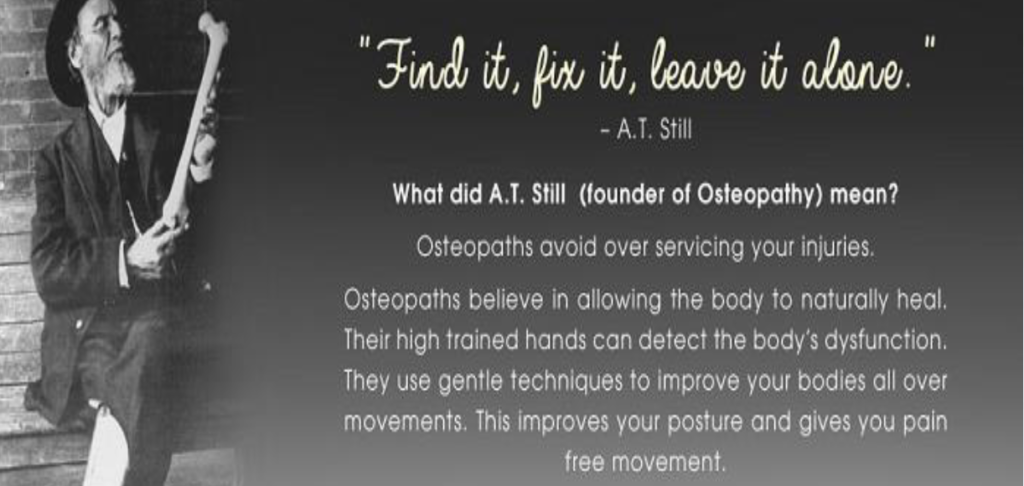
One of Still’s early students was J Martin Littlejohn, who, after taking on a job as physiology lecturer at the American School of Osteopathy, registered as a student. He was made Dean of the school that same year. Following bitter disagreements with some of A.T. Still’s followers regarding the role of physiology within osteopathy, as well as other factors, he was released from his role as Dean, and moved to Chicago, where he established the Chicago College of Osteopathy in 1900. Theoretical education was expanded upon and physiology became a core subject. Despite criticisms from the American School of Osteopathy, the Chicago College of Osteopathy went from strength to strength and was seen as a key scientific osteopathic institution. Due to the onset of political changes, J Martin Littlejohn moved back to Britain with his family in 1913, where he worked in hospitals in a variety of jobs, until he helped found the British School of Osteopathy (BSO) and the Journal of Osteopathy in 1917. This helped to lay foundations for osteopathy in Europe.
PRINCIPLES OF OSTEOPATHY
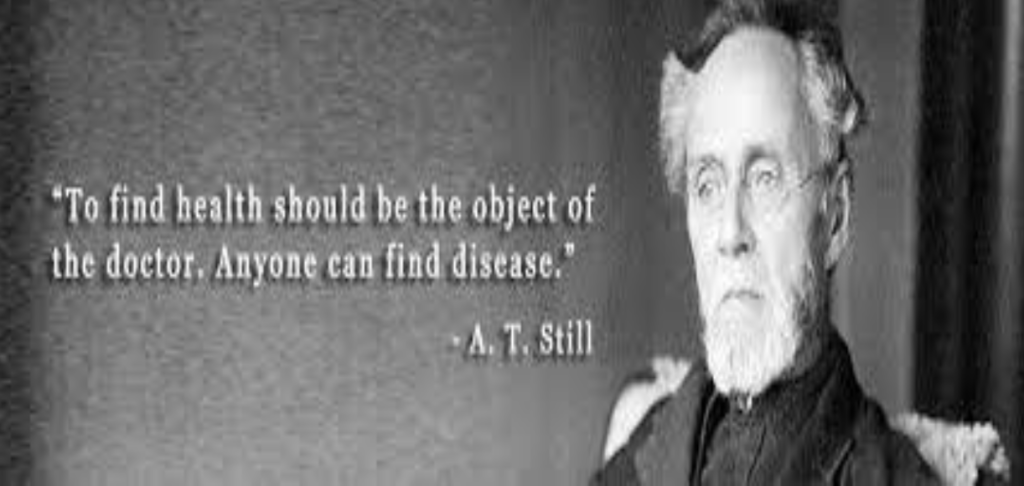
The four major principles of osteopathic medicine are the following.
1. The body is an integrated unit of mind, body, and spirit.
2. The body possesses self-regulatory mechanisms, having the inherent capacity to defend, repair, and remodel itself.
3. Structure and function are reciprocally interrelated.
4. Rational therapy is based on consideration of the first three principles.
One integral tenet of osteopathy is that problems in the body’s anatomy can affect its proper functioning. Another tenet is the body’s innate ability to heal itself. Many of osteopathic medicine’s manipulative techniques are aimed at reducing or eliminating the impediments to proper structure and function so the self-healing mechanism can assume its role in restoring a person to health.[32] Osteopathic medicine defines a concept of health care that embraces the concept of the unity of the living organism’s structure (anatomy) and function (physiology).
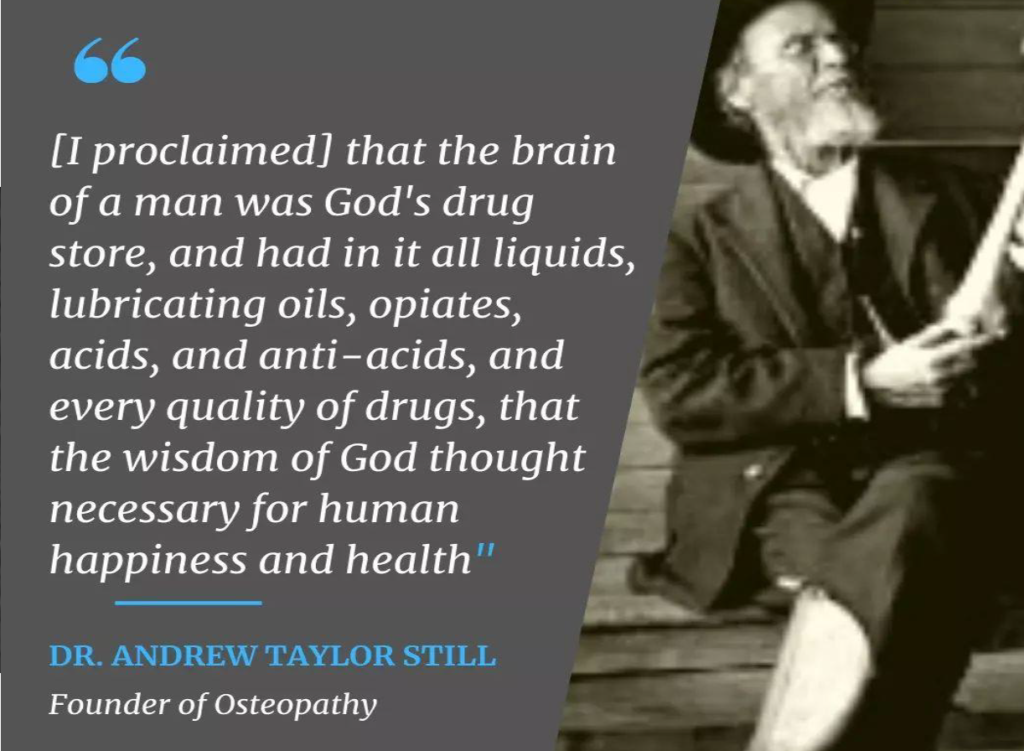
OSTEOPATHY PROFESSION
There is an increased growth in the osteopathic profession in india:
The number of Osteopaths and osteopathic students in India – increase over the past decade.
Since its establishment 130 years ago, the osteopathic profession has forged tremendous growth to become one of the most impactful and influential contributors to the healthcare system. What began as a distinctive philosophy of medicine founded by a frontier physician in 1892 has evolved into a vibrant and diverse community of osteopaths and medical students who combine medical expertise with a whole-person approach focused on listening and partnering with their patients.
BUILDING OUR FUTURE
With a focus on providing care for underserved communities, the majority of osteopathic practitioners are located in urban areas, leaving rural areas with limitations on access to care. Graduates play a critical role in helping to counter the nation’s practitioners shortage and provide underserved populations with much-needed access to care provided both by primary Osteopaths and specialists
AFFILIATE ORGANIZATIONS
Educational institutions, affiliates, partners and teams
Serving an osteopathic community of Osteopaths and Osteopathy students throughout India.
The Osteopathy Association of India works closely with a number of groups to encourage growth of education, science and knowledge of osteopathy. These groups provide a number of services by location, by specialty and within different areas of the osteopathic medical profession.
Osteopathy students attends an osteopathic Institute
The OAI’s Commission on Osteopathic Institute Accreditation, accredits osteopathic medical Institutes which offer instruction at different teaching locations.
Connect with Osteopaths in your specialty
The Osteopathy Association of India works with osteopathic specialty Institute to advance osteopathic medicine.
A number of organizations work to represent various osteopathic specialties and subspecialties. Contact these specialty study groups to learn how they promote the practice of osteopathy.
Connect with Osteopaths in your state
The Osteopathy Association of India works closely with affiliated state associations to encourage growth of education, science and knowledge of osteopathy.
Connect with Osteopaths in an interest area
Learn more about the role osteopathic study groups, Groups of practitioners play in supporting Osteopaths.
Health IT & Innovation
The OAI helps osteopaths advance patient care through health information technology, practice management support, advocacy and strategic partnerships. The OAI works to train doctors, support research and educate the community about the Different recent concepts in Osteopathy like FDM, Etc and its benefits, for individuals and for society at large.
COLLEGES & STUDENTS
Student Wing - Osteopathy association of India(SOAI)
OAI lends support and assistance to the nation’s osteopathic students, and serves as a unifying voice for osteopathic medical education. OAI represents the administration, faculty and students of all of the osteopathic educational Institutes in the India.
SOAI is the student affiliate organization of the Osteopathy Association of India. SOMA promotes osteopathic ideals and unity within the profession, educates future osteopaths, and establishes and maintains lines of communication among health care professionals in an ongoing effort to improve the quality of health care.
Womens wing - Osteopathy association of India(WOAI)
The WOAI is composed of the women students of Osteopathy and the practicing Women Osteopaths. The purpose of the organization is to provide a mechanism for the interchange of ideas among osteopathic women students and other concerned women osteopathic practitioners about Women’s Rights, Equality and Scope of Practice. The Organisation also helps Women students of Osteopathy and the practicing Women Osteopaths to address their issues related to Sexual harassment or Complaints related to gender inequality.
OAI - INTERNATIONAL
OAI International – Our organization dedicates to providing much-needed healthcare to indigent and isolated people in remote areas around the world.The purpose of the OAI is to advance the philosophy and practice of osteopathic medicine and osteopathy throughout the world.
OAI - FOUNDATIONS
The OAIF serves as the philanthropic arm of the Osteopathy Association of India. Contributions to the OAI benefit thousands of osteopathic medical professionals through grants, scholarships, and awards to students, OSTEOPATHS, researchers, and osteopathic programs. The Osteopathy association of India supports community health initiatives works to advance osteopathic medical care, medical research and osteopathic medical education locally and nationally.
OAI - EVENTS
OAI education conferences, advocacy events and policymaking meetings
Join us for OAI-hosted events that inform, influence and inspire.
Looking for top-rated osteopathic education and meaningful networking opportunities?
Or perhaps you’re looking to become more involved with your colleagues across the osteopathic profession. Whatever you’re looking for, the Osteopathy Association of India has you covered. Our annual line-up of osteopathically-focused events provide both in-person and virtual opportunities for professional education, innovation and growth. Check out the options below to get started making an impact and building connections.
1st NATIONAL OSTEOPATHY CONFERENCE
2ND NATIONAL OSTEOPATHY CONFERENCE
OAI - Chief Executive Committe
Voice of the profession
The OAI leadership and executive offices represent Practicing osteopaths and medical students across the country. Charged with implementing the vision and strategic plan of the OAI, these leaders play an integral role in guiding the actions of the profession on behalf of the osteopathic family.
Officers and Executive Leaders
President: R.Prasanna Venkatesan
Vice President: Madhulika Sethiya
Secretary: Bala Kumaran
Treasure: Reshyma Sultana
Honorary Member:
- Narkeesh Arumugam
- Maneesh Arora
- Jaswinder Singh
Executive Members:
Deepika Venkatapathi
P. Anjan kumar
F.Selvin Julious
Senthamaraikannabn T
Chandrasekar Subramani
Vijayamuthu
D.Jeferson Pon David
Vandhana
Masooma
Rohit.
Vinayak Dendge
